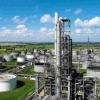dear all,
marry X'ms and happy new year.
i need some help on the tower pressure control for the debutanizer column having total condenser.
among various option for controlling tower pressure, such as hot vapor bypass and flooded condenser type,etc. which one is preferred and why ?
as per my information, flooded type condensers are more preferred.
[[u] do not have the sufficient knowledge on the control philosophy and working of flooded type condenser design.
I request to throw some light on this very important concept(esp on the flooded condenser design)]
Thks in advance.
hiren desai
|
|
Tower Pressure Control
Started by hirengdesai, Dec 28 2006 01:35 AM
4 replies to this topic
Share this topic:
#1

Posted 28 December 2006 - 01:35 AM
#2

Posted 28 December 2006 - 02:36 AM
Hi, as far as I know there are 3 ways for tower pressure control of total condensers, and they follow the same principle:by manipulating reflux drum (RD) temperature we control pressure :
1. with cooling water-by decreasing CW we increase T in RD, vapor pressure increases, so
pressure increases
2. flooding condenser: first RD gets filled up, level in condensator increases, so area for
condensation decreses- pressure increases
3. hot vapor bypass around condenser :by opening HVB valve the liqiud from condenser is
not cold enough to condense the stream coming from valve, so remaining vapor will
accumulate in RD and pressure increases
1. with cooling water-by decreasing CW we increase T in RD, vapor pressure increases, so
pressure increases
2. flooding condenser: first RD gets filled up, level in condensator increases, so area for
condensation decreses- pressure increases
3. hot vapor bypass around condenser :by opening HVB valve the liqiud from condenser is
not cold enough to condense the stream coming from valve, so remaining vapor will
accumulate in RD and pressure increases
#3

Posted 28 December 2006 - 03:50 AM
Hello hirengdesai,
When having total condensation (100% condensibles) of tower overhead stream, employing flooded condenser pressure control is the best solution - according to many experienced process designers.
Throttling CW flow or introducing hot vapor bypass has some drawbacks, which are discussed in many ChE articles and literature (water-side fouling in condenser, vapor leakage through HVB line etc.). I suggest you to read chapter "Tower pressure control" in N. Lieberman's book "Working guide to process equipment", where it is explained in details how to choose the best method for controlling tower pressure, depending on your actual service. Flooded condenser pressure control has unique hydraulic/mechanical design issues.
Also, I am attaching an article by A. Sloley, which is a general guide for pressure control systems - an algorhytm-type approach for pressure control method selection.
Hydraulic concerns in hot vapor bypass systems are explained in the article "Diagnosing instabilities in the column overhead", by H. Kister.
When having total condensation (100% condensibles) of tower overhead stream, employing flooded condenser pressure control is the best solution - according to many experienced process designers.
Throttling CW flow or introducing hot vapor bypass has some drawbacks, which are discussed in many ChE articles and literature (water-side fouling in condenser, vapor leakage through HVB line etc.). I suggest you to read chapter "Tower pressure control" in N. Lieberman's book "Working guide to process equipment", where it is explained in details how to choose the best method for controlling tower pressure, depending on your actual service. Flooded condenser pressure control has unique hydraulic/mechanical design issues.
Also, I am attaching an article by A. Sloley, which is a general guide for pressure control systems - an algorhytm-type approach for pressure control method selection.
Hydraulic concerns in hot vapor bypass systems are explained in the article "Diagnosing instabilities in the column overhead", by H. Kister.
#4

Posted 02 January 2007 - 12:56 AM
dear zauberberg and popay,
thks a lot for the reply.
Sadly, I am still not clear on the typical installation of this type of arrangement.
warm regards,
hiren desai.
thks a lot for the reply.
Sadly, I am still not clear on the typical installation of this type of arrangement.
warm regards,
hiren desai.
#5

Posted 06 January 2007 - 01:23 PM
Hirengdesai,
Please try to find the literature I mentioned in my previous post.
Your company's library should have Lieberman's books - they are all 100% classic. You may also search for G. Shinskey's book, "Distillation control".
Best regards.
Please try to find the literature I mentioned in my previous post.
Your company's library should have Lieberman's books - they are all 100% classic. You may also search for G. Shinskey's book, "Distillation control".
Best regards.
Similar Topics
Distillation Tower Top And Bottom Temperature And PressureStarted by Guest_student55_* , 27 Mar 2016 |
|
|
||
Level Control ValveStarted by Guest_Ilyes_* , 03 Jun 2025 |
|

|
||
Steam Pressure In Heat ExchangerStarted by Guest_mvanrijnbach_* , 15 Apr 2025 |
|

|
||
Critical Pressure For Choke Valve SizingStarted by Guest_Sherif Morsi_* , 07 Nov 2017 |
|

|
||
Steam Carrying Liquid From The Sour Water Stripping TowerStarted by Guest_kaidlut_* , 12 Sep 2024 |
|

|

 FB
FB







